28 Apr 2023
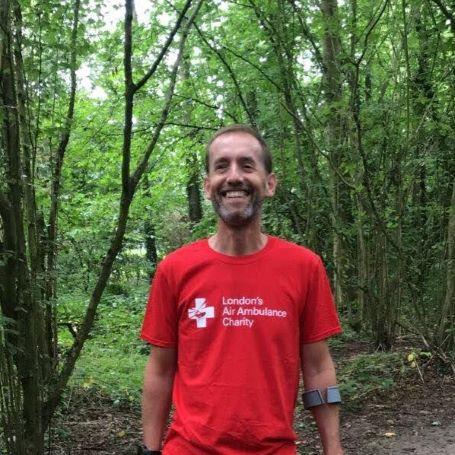
On New Year’s Day 2021, Clare set off from her home in Surrey on a walk. It was a grey, misty morning and her husband Steve, not far behind, was heading out on a run.
After following one of her regular routes, Clare came across an irregular scene. The road ahead was closed and full of first responders: police cars and land ambulances scattered across the road.
Calling Steve to warn him to avoid this road, Clare found he did not answer. “That was weird,” she said, “so I checked his phone tracker to see where he was. It said he was on that road, so I walked up further to find him, presuming he was being kind and helping someone.”
Unfortunately, that was not the case. Steve had been jogging up the road – wearing bright clothes and sticking to the pavement – when a car had lost control, mounted the pavement and hit Steve from behind at speed.
“Once the police confirmed who I was, a paramedic came over to me whilst a team worked on Steve and told me how poorly he was. London’s Air Ambulance team had already arrived and were preparing to operate on Steve.
“We’re so lucky they got here from London in the time that they did. Any longer and Steve would not have made it.”
It was very clear to London’s Air Ambulance’s advanced trauma team that Steve was incredibly unwell. Upon assessment they quickly identified that he was not breathing effectively, was very pale and only had a central pulse. His blood pressure and oxygen levels were also extremely low. They suspected that Steve had, amongst many injuries, a life-threatening pelvic fracture from which he was bleeding internally, collapsed lungs and a badly broken leg.
The team started a blood transfusion for Steve, took over his breathing by inducing him into a coma and decompressed his chest to reinflate his collapsed lungs. Bleeding caused by a broken pelvis is notoriously difficult to control, which is why in 2014 London’s Air Ambulance developed an innovative procedure called REBOA that can be deployed in the pre-hospital phase to stop patients from bleeding to death. It involves passing a catheter through to the main artery in the body and inflating a balloon at the tip of the catheter to stop blood flow to the pelvis.
On the roadside, Steve underwent this high-risk procedure administered by London’s Air Ambulance’s advanced trauma team, to give him the best chance of getting to hospital.
“It blows my mind what the team were able to do, there on the roadside on a freezing cold New Year’s Day,” said Clare.
Once Steve had been stabilised, he was then taken to hospital, where he was met by an extensive team of clinicians who took over his care.
“Once we got to A&E, I was allowed to see Steve very briefly before he was wheeled away to have emergency surgery, and that was that. It was during the peak of COVID-19 so I wasn’t allowed to follow him or wait for him. I just had to go home, continuously worrying he might not make it, or he might get COVID-19.”
Steve was kept on a ventilator in intensive care for four days, during which time the doctors stopped the bleeding in his pelvis and stabilised his pelvis and leg. On day five, Steve was gradually woken up.
“I felt like I had been dreaming – I’d been dreaming I’d been drowning in snow. Then I looked down and saw one leg in a brace and the other in a pulsating clinical sleeve, I had no idea what was going on,” said Steve. “I had no recollection of the accident, nothing from that day at all. I had no idea where I was or why I was there.
“That prolonged untangling of working out what happened was trauma after trauma. I didn’t have a phone, so I couldn’t have any contact with Clare and the family. I had to slowly unpick the events that led me to hospital by talking to various staff members over several days.”
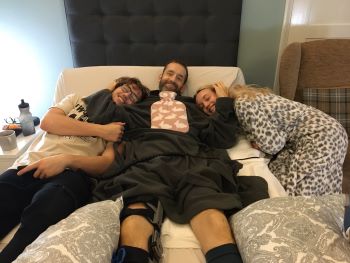 Clare said: “He needed help with the simplest of tasks – like feeding himself because he couldn’t sit up. All I wanted to do was go and help him. But I couldn’t.”
Clare said: “He needed help with the simplest of tasks – like feeding himself because he couldn’t sit up. All I wanted to do was go and help him. But I couldn’t.”
On 13 January, Steve had a second operation on his pelvis. On 20 January, he was discharged home. “My family hadn’t seen me for three weeks. It was very traumatic, as who arrived home wasn’t the person they had last seen.”
Steve was taken home in a wheelchair and because of the pelvic injury, he was unable to move himself or get out of bed – he needed to keep his body stable.
“We converted the lounge into his bedroom, with a special electric bed,” said Clare. “But when he arrived home, he was still in a hospital gown, and he looked awful. That night is something that will stay with me and the children for the rest of our lives, it was hideous.
“Initially he wasn’t allowed to walk, eventually he could transit himself to a chair, and then after 19 March he was able to start taking steps using a Zimmer frame.”
Primarily a runner before his accident, Steve had been of slim build with minimal fat. Unfortunately, this meant he suffered significant muscle wastage. “I was very weak and very thin, and it was uncomfortable to do most daily tasks. Even simply sitting was almost unbearable.”
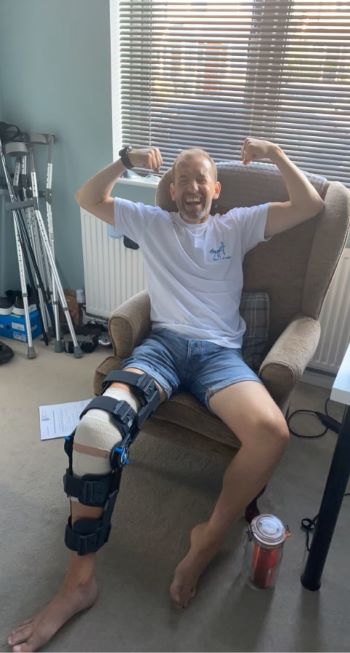 With mental strength and sheer determination, Steve began an extensive physio programme. Weekly sessions helped him learn how to support his own weight, how to walk in a straight line, practice walking up stairs and manoeuvre over steps.
With mental strength and sheer determination, Steve began an extensive physio programme. Weekly sessions helped him learn how to support his own weight, how to walk in a straight line, practice walking up stairs and manoeuvre over steps.
“Everything gets taken away from you and being static was crushing me. So, you try to start again and gradually you start to claw back some of your previous capabilities.
“I was taking everything as far as I could – the physio, the gym, nutrition – to try and rebuild my life.”
Now, two years post-accident, Steve is still working hard on his recovery. “I can do a lot of things that I used to be able to, but nowhere near as fast or as far or as frequent. But the clinicians have said I am already in a position they never thought I would reach.”
Steve is still doing physio once a week and continuously striving to improve. He is back running, but now views it differently. “I still enjoy it but it’s a very different experience. The carefree nature of exercise is gone, now I have to think about how I can improve my technique to stop the unpleasant feeling when my feet hit the ground. It’s thinking about all these things that before were just natural movements.”
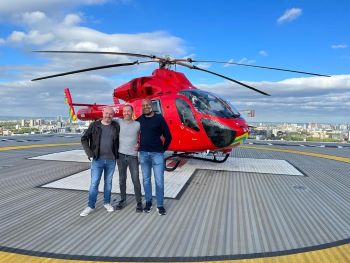 Earlier this year, Steve, Clare and their two children visited London’s Air Ambulance Charity’s helipad along with Steve’s father, brother and sister.
Earlier this year, Steve, Clare and their two children visited London’s Air Ambulance Charity’s helipad along with Steve’s father, brother and sister.
“Meeting the people who saved me was surreal. When you realise the depth of the treatment and the skills they bring to the scene – it’s astonishing. Anything I could do to thank them, I would.”
Also, during the summer of 2021, the entire Blake family participated in our Miles for Missions challenge – walking 116 miles (the length of the border that London’s Air Ambulance covers) each.
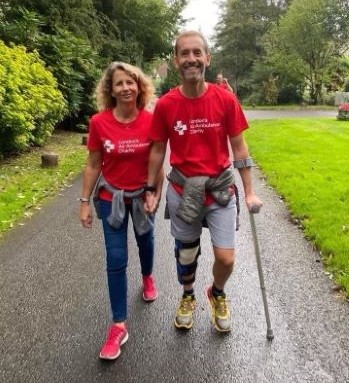 “We all did it, it gave us something to focus on. We really truly enjoyed it,” said Clare. “Every single one of us did 116 miles, and Steve joined us for the last mile, which was absolutely amazing.”
“We all did it, it gave us something to focus on. We really truly enjoyed it,” said Clare. “Every single one of us did 116 miles, and Steve joined us for the last mile, which was absolutely amazing.”
“The trauma we’ve been through still stays with us – every time one of us is going out to run, we always say, ‘be super careful’ and are reminded of that day. The reality that something like that can happen to anyone at any time is scary.
"When it did happen to my family, thank goodness London’s Air Ambulance was there.”
Please watch Steve and Clare's video below:

